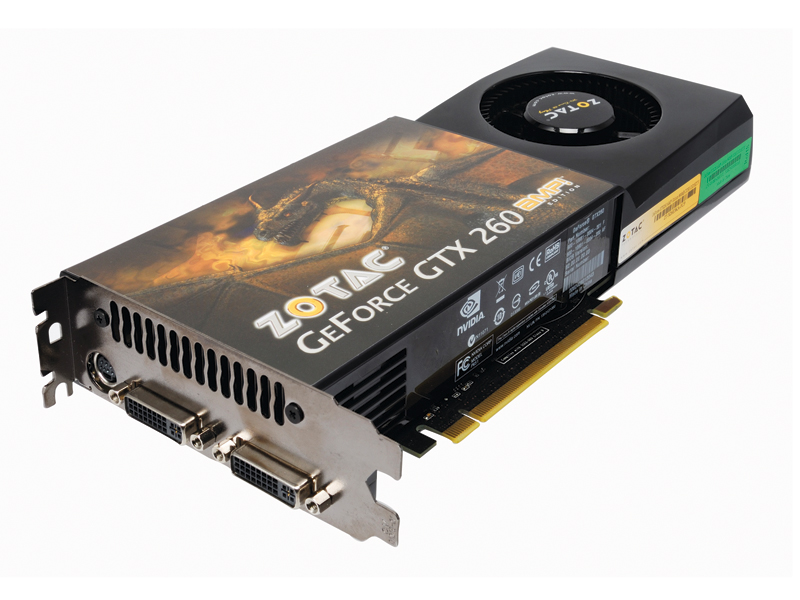TechRadar Verdict
The 260 consolidates its status as the 200-series card for anyone with half a brain
Pros
- +
Overclocks tremendously
- +
Almost as cheap as standard 260
- +
No bigger/louder than standard 260
Cons
- -
Not enough for very high-res Crysis
Why you can trust TechRadar
Want a GeForce GTX 260? If you've been running a GeForce 8 until now, you'll probably need a new power supply to fuel its twin six-pin connectors.
You might find you also need a new motherboard, as the colossal length of this board sees it headbutting against SATA and IDE sockets – on some boards, there simply isn't the space. On those that do, you'll need a clutch of new SATA cables if you're not already equipped with the low-profile ones with the l-shaped plugs. You may even need a new PC case to house your fatboy.
To rock the 280, the 260's meatier sibling, you'll almost definitely need a new PSU, as, in addition to needing more juice than a 600 watter can realistically supply, it demands the new-ish 8-pin power plug alongside the now-traditional six-pin. The horror, the horror.
- Also read: 15 best graphics cards in the world today
For a great many punters, the GTX card isn't the simple, standard graphics upgrade it appears to be: it may require a total rethink of your entire system.
Faster performance
But is it worth it? If you're running a pre-GeForce 8 card, certainly. If you're already on a high-end GeForce 8/9 series or Radeon HD…it's more tricky.
We established before that the GTXs are fine cards indeed, but the clout they bring may not be Olympian enough to justify the expense. This is especially true for the 280, which doesn't squeak far enough ahead of its cheaper cousin for our money.
With this month's release of pre-overclocked versions of both cards, the game might have changed a little. In theory, Zotac's GTX 260 Amp! and Asus's pimped 280 both run faster out of the box without harming stability and have more headroom for your own warranty-worrying.
Overclocking headroom
The 260 adds 76MHz to the GPU and 51MHz to the GDDR3, which leapfrogs a stock 280 in terms of raw speed.
Clearly it's still hampered by fewer ROPs, Texture Units, Stream Processors and RAM, but it fetches up coolly, offering only a handful fewer frames per second in our Crysis and Word in Conflict benchmarks.
The ultimately minor real-world differential between a 260 and 280 means it doesn't dramatically out-perform a vanilla 260 – but to add some context, we're talking about a £225 card standing very nearly eye-to-eye with a £300 one. And that's before you factor in the AMP!'s extra overclocking headroom.
While our stock 260's GPU fell over at 670MHz, this ran stably at 693 – and when doing so was the tiniest of noses ahead of a plain 280 when running Crysis at the fabled Very High settings (with a cheeky 4x anti-aliasing slapped on to boot).
While we're yet to roadtest any rival pre-overclocked 260s, right now the Zotac looks like the 3D card to buy – especially given the cheapest you'll find a standard 260 is only a tenner less than this.
Improved gaming
The news isn't so good for Asus' pumped-up take on the GTX 280. There was already a sense that the 280 was pushing the GT200 core as far as it would go in its current 65nm flavour (a 55nm revision is due later this year), and the claustrophobic overclocking headroom only serves to confirm that.
It whacks the GPU up from 602 to 670Mhz and the memory from 1106 to 1150 – an equivalent leap to what the 260 Amp! manages over the stock 260. The real-world improvement is roughly analogous, too – you can expect just a couple of frames extra in graphics-intensive games.
Crank it up to 706Mhz and that addition is doubled – 24.5fps in Crysis Very High, and and 28 if you kill the anti-aliasing. So nearly that mythical 30, and a minor settings sacrifice will win you it – there's no denying the GTX 280's got punch.
And the winner…?
Unfortunately, our comparison 280, a standard-clocked Gigabyte model, also goes to 706MHz. Both cards fall over if you inch any higher, so Asus' overclocked model isn't really buying you anything extra, except peace of mind that you're a bit more warranty-shielded if it does melt down at 650MHz.
The £100 rider on the 280 over the 260 makes it a tough card to recommend, but it's worth mentioning that both boards have seen price cuts in the wake of ATI's nearly-as-mighty, crazy-cheap Radeon HD 4850.
These are the better cards, most especially at higher resolutions and with anti-aliasing, but even at the lower prices the 4850 seems the more rational choice. It's positively svelte compared to these twin-slot horrors, too.
Nevertheless, Zotac's GTX 260 Amp! comfortably wins the day, and our hardware hearts. £225 (if you shop smart online) for a card that's within spitting distance of as good as it gets? So long as your PC can physically take its enormous bulk and frightening power-thirst, you're looking at your new GPU god right there.
